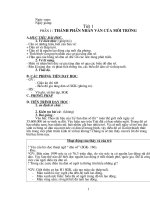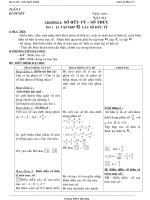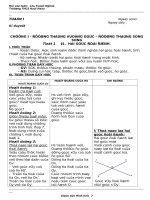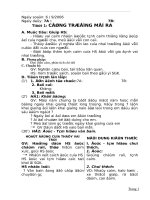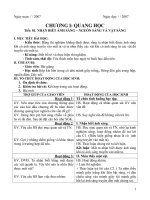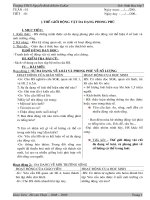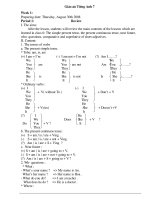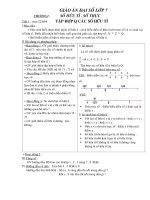Giao an Anh 7Giao an av 7 k 1.doc
Bạn đang xem bản rút gọn của tài liệu. Xem và tải ngay bản đầy đủ của tài liệu tại đây (277.53 KB, 71 trang )
Teaching plan
English 7
Date:
Period 1: Consolidation
A. Aims: By the end of the lesson, Ss will be able to grasp the contents of grade 6 and
know something about grade 7.
B. Teaching aids: table and books
C. Procedure
I. Consolidation:
Use the tables to introduce the grammar of grade 6
- The tenses:
+ The present simple tense
+ The present continuous tense
+ The near future tense
Give some exercises and ask Ss to do to recognize them.
- Comparison:
+ Comparative of short adjective: Adjective + er
+ Superlative of short adjective: The + adj + est
II. Introduction: There are sixteen units in this programme. Each unit has 2 parts (A, B)
1. Presenting new words: Listen - Repeat / Listen - Read
2. Checking comprehension: Ask - Answer / Practice with a partner / Match / True and
False.
3. Practice: Listening - Speaking - Reading and Writing
4. Remember: Helping Ss consolidation the contents of the lesson which they’ve
learnt.
5. Language focus: Summarize the words, phrases and structures after each three unit.
6. Grammar - Glossary
Guide Ss to prepare the next lesson: Unit 1 (A1,3,4,5)
1
Date:
Unit 1: back to school
Period 2 + 3: Lesson 1: A - Friends (A12345)
A. Objectives: By the end of the lesson, Ss will be able to know how to greet and introduce
oneself.
B. Teaching aids: books, cassette, chalks, board…
C. Procedure
I. Warm up
Ask some questions about the new school year. - Listen and answer
+ What do you do during your summer
vocation?
+ What do you say to your friends when you
first meet after the summer holiday?
+ Are you happy to be back again?
Lead in the new lesson
II. New lesson
1. Listen. Then practice with a partner
- Introduce the new lesson and ask Ss to book at
the book (1a, 1b/10) - Look at the picture
- Turn on the tape (2 times) - Listen. Then repeat in chorus
- Ask Ss to practice - Work in groups
Explain:
+ Nice to see you
+ Nice to see you again
+ So am I
Practice before class
- Now answer - Copy down
- Work in pairs (3 pairs)
- Work in pairs
Listen and correct. Then give the correct
answers.
S
1
: Ask
S
2
: Answer
- Copy
3. Listen. Then practice with a partner
- Ask Ss to look at the picture (p12) - Look at the picture and answer the
questions.
+ What are they doing?
They are greeting each other
- Introduce the situation of the dialogue and turn
on the tape once.
Explain: Greeting!
- Listen to the tape
2
+ Good morning/ afternoon/ evening
+ Hi - Hello
- Copy
- Turn on the tape (twice) - Listen and repeat in chorus (without
book).
Conclusion: Greet the older people - Work in pairs (3 pairs)
4. Listen. Complete these dialogues
- Ask Ss to look at the box and explain the uses
of and meanings of the questions.
- Listen and copy
- Guide Ss to complete the dialogues - Listen to teacher
- Turn on the tape (2-3 times) - Listen and complete
- Listen and correct the mistakes + 4 pairs demonstrate before class
+ Practice
5. Listen. Write the letters of the dialogues in the
order you hear.
a) Pre: Ask Ss to look at the pictures and answer
the questions. - Answer the questions
+ Who are they in the pictures?
+ What are they doing?
Notice on the time of each picture
You’ll hear 4 conversations describing the
pictures but they’re not in order. You listen to
them and mark the number in good order as
conversations in the tape.
b) While:
Turn on the tape (3 times) - Listen and do the exercise
Correct and give the key? - Give their results
c) Post: Ask Ss to work in pairs - Copy
- Work in pairs
Homework: Give and guide Ss to do the exercise
1) Copy all the dialogues they’ve learnt
2) Do exercise 3, 4 / workbook
3) Prepare the next lesson
3
Date:
Unit 1: back to school
Period 4: Lesson 3: B1, 2, 3, 4
A. Objectives: By the end of the lesson, Ss will be able to introduce others, ask and answer
about personal information.
B. Teaching aids: books, cassette, sheet work…
C. Procedure
I. Checking up old lesson
Call 3 Ss to demonstrate the dialogues 3, 4, 5/ p 12,13. - Demonstrate
II. Warm up: Introduce the pictures and ask
+ This is Miss Lien
+ What does she do?
+ Where is she?
- Answer
To lead in
III. New lesson
B1. Ask Ss to look at the picture 1/15
Hang the board with
- Look at it and guess the answer
+ Who are they in the picture?
+ Where are they?
+ What are they doing?
+ What is the teacher doing?
+ What are the students doing?
+ What are they talking about?
- Turn on the tape once and explain some words - Listen to the tape
+ family name ≈ surname
+ middle name
Eg: Ph¹m ThÞ Hoa
family name middle name first name
+ My family name is Nguyen
+ My middle name is Van
- Practice introducing their
family name and middle name.
- Turn on the tape twice and ask them to practice - Listen and repeat in chorus (2
times)
Listen and correct mistakes - Work in pairs (5’)
Now answer: - Work in pairs (6’)
- Give the right answers + Some Ss write on the board
+ Copy down
B2. Write. Complete this dialogue
4
- Ask Ss to look at the picture and ask
+ Who are in the conversation?
+ What are they talking about?
- Look at it, read the dialogue
and answer.
- Explain the aims of the exercise - Listen and do
- Correct and give the keys - Give the answers
Who - Who - What - Where - Where - How + Copy and practice the
completed dialogue.
Asking:
+ Who is that?
+ Where does he/she live?
+ How old is she? - Answer
B3. Ask Ss to look at student card and explain: name,
age, class, school and home address.
- Listen
Now if you want to ask one of your friend’s name to
complete the first time of the conversation, how will
you ask?
Eg: What’s your name?
Ask them to practice - Ask and answer. Then
complete this form.
- Demonstrate before class
Homework:
1) Copy B1, 2 in their notebooks
2) Do exercise B1, 2 / workbook
Prepare the next lesson
Date:
Unit 1: back to school
Period 5: Lesson 4: B4, 5
A. Objectives: By the end of the lesson, Ss will be able to ask about transportation and
distances, know how to ask:
How far . from to ? about meters / km……… … … ……
How do/does + S + V?
Skill: pair works and group works
Listening
B. Teaching aids: books, board, cassette
5
C. Procedure
I. Warm up: Guide Ss to play games
Word square - Work in groups
Remark and lead in
Draw 2 houses: Lan’s house
two people
Nam
Lan
Ask and answer about distances
II. Presentation
4. Set the scene to lead in
a) Where does Hoa live?
b) Is it very far from her school?
c) How many kilometers?
d) How does she go to school?
- Look at them and guess the
answers.
- Turn on the tape twice - Listen and find out the answers.
Explain:
+ How far is it from your house to school?
It’s (about) meters / kilometers……
+ How do/does + S + V?
S + V + by (means of transport)
+ the market ; school
- Work in pairs with the market,
the bus stop.
- Copy down
B5. Now use the structures you’ve learned, let’s ask
and answer about the distance between these places:
market, movie, theater, post office, bus stop - Listen and copy
Correct and give further information to ask them to
practice.
- Work in pairs, using:
How far is it from . to .?… …
It’s (about) ……
6
W W W H Y 5
H W H E N why, when, on, to, from
E B A O N 4
R Y T O W where, by, what, at
E F R O M 2 who how
school
school
the market
the post office
the movie theater
Homework:
Give and guide Ss to do the exercises
1) Copy B5
2) Do exercise 3, 4 / workbook
Prepare the next lesson
Date:
Unit 1: back to school
Period 6: Lesson 5: B6, 7
A. Objectives: By the end of the lesson, Ss will be able to listen and write about distances:
How far is it from to ?… …
Skill: listening and writing
B. Teaching aids: books, cassette…
C. Procedure
I. Warm up: Ask and answer about yourself
(name, age, address, distance, transport, place, ).…
- Ask and answer
II. New lesson
B6. 1. Pre-listening:
- Ask Ss to look at the picture and introduce the places
in the pictures: Lan’s house, school, post office,
market, theater.
- Listen to teacher
- Ask some questions:
+ Is Lan’s house near/ far from school?
+ Is Lan’s house near the market/ the post
office/ the theater?
- Look at the picture and answer
Now you will hear 4 conversations and find out the
distance between the places mentioned in the tape.
- Listen to introduction
2. While listening
- Turn on the tape three times - Listen and copy the answers
- Give the answers and write on
7
1 km
30 km
700 km
2 km
the board
- Turn on the tape the last time and pause each sentence
to correct mistakes. Then give the correct answers. - Copy down
3. Post-listening
Ask Ss to practice about distances they’ve listened. - Work in pairs
B7. The survey
Write the survey on the board
Name What
Address Where
Means of transport How
Distance How far
- Practice asking and answering.
Then copy.
- Read their survey form.
Listen and correct
Homework:
Give and guide Ss to do the exercises
1) Copy B 6, 7 in their notebooks
2) Do exercise 5 / workbook
Prepare the next lesson
Date:
Unit 2: personal information
Period 7: A. Telephone numbers
Lesson 1: A 1, 2, 3
A. Objectives: By the end of the lesson, Ss will be able to identify numbers and know how
to phone. The simple future with “will”.
Skill: pair works and group works
B. Teaching aids: books, chalks, board and cassette
C. Procedure
I. Warm up: Show a telephone and ask - Listen and answer:
+ What’s this?
+ My telephone numbers is 884846 and
introduce the telephone.
It’s a telephone
II. New lesson
1. Read: Telephone directory
Ask Ss to look at the book and ask
8
+ Where is this page from? - Look and answer
Telephone directory
- Guide Ss how to read telephone numbers.
Code
Eg: 8 211 800
eight two one one eight zero zero
eight two double one eight double zero
- Listen and repeat
- Read telephone numbers aloud and ask them to
practice.
- Listen and repeat in chorus
- Work in pairs
2. You will listen to some people s telephone numbers.’
You write down the numbers you hear.
S
1
: Read names
S
2
: Read numbers
- Listen and make pre-parathions
to do the exercises.
- Turn on the tape 3 times - Listen and copy the telephone
numbers they have listened.
Correct and give the keys and turn on the tape to check. - Compare their results and read
them aloud.
+ Copy down
3. Ask Ss to look at the picture (3/20) and ask some
questions:
- Look and answer
+ Do you often talk with so on the phone?
+ Do you know the question asking for
telephone numbers?
+ Do you know how to give your telephone
numbers to other people?
- Turn on the tape once / twice - Listen and answer
What’s your telephone numbers?
- Listen and repeat in chorus
- Explain: Excuse me!
Yes?
I’ll call you soon
- Copy down
will (‘ll) The simple future - Work in pairs
- Ask Ss to look at the personal form and guide them to
practice: - Look at it and practice
+ What’s your name?
+ Where do you live? / What’s your address?
+ What’s your telephone numbers?
Homework: 1) Copy A3
2) Do exercise 1, 2/8 workbook
3) Prepare the next lesson
- Copy down
9
Date:
Unit 2: personal information
Period 8: Lesson 2: A 4, 5 (6)
A. Objectives: By the end of the lesson, Ss will be able to know how to talk on the phone
and make an arrangement.
Skill: listening
B. Teaching aids: books, cassette, chalks and board…
C. Procedure
I. Warm up: Greetings and present the pictures to
students. - Listen
II. New lesson
A4. Ask Ss to look at the pictures (4) and ask some
questions.
+ Who are they in the picture?
+ What are they doing?
+ What are they talking about? Can you guess?
- Look at the picture and answer
the question.
Now look at the conversation and listen to the tape.
What are they talking about? - Listen to the tape and look at
their books.
- Explain:
Future simple tense:
( + ) S + will + V
( - ) S + will not (won t) + V’
( ? ) Will + S + V?
Yes, S + will / No, S + won t’
- Listen and copy. Then give
examples.
+ Would you like to + V?
+ See a movie
+ Let’s meet at ……
- Turn on the tape once more and ask them to practice. - Listen to the tape and work in
pairs.
After practicing the conversation, now answer the
questions about it. - Work in pairs
Give the right answers - Copy down
A5. a. Pre: Ask Ss some questions
- Listen and answer
+ Do you sometimes go to the movies?
+ What do you say to ask your friend to go to
the movie theater with you?
+ Do you need the place to meet?
10
+ How to get to the theater?
b. Correct and guide Ss to look at part 5 and do
the exercise.
- Look and listen to the tape to do
the exercise. Then compare their
results.
- Demonstrate
- Turn on the tape (twice or 3 times)
- Turn on the tape again and pause each sentence.
Then give the right answers.
c. Post: Asking Ss to practice “mapped dialogue”
- Practicing
Listen and correct. Then give the completed dialogue. - Copy down
Homework:
1) Translate A4 into Vietnamese
2) Do exercise 3, 4, 5/9 workbook
- Write down
Date:
Unit 2: personal information
Period 9: Lesson 3: B 1 2 3
A. Objectives: By the end of the lesson, Ss will be able to speak and write ordinal numbers,
dates and months.
Skill: listening, speaking and writing
B. Teaching aids: books, cassette, chalks and board…
C. Procedure
I. Warm up and checking the old lesson - Reply
Call some Ss to read: 884 846 / 963 728 / 04 0 525 575
II. New lesson
1. Ask Ss to look at the picture and introduce ordinal
numbers.
- Look and listen
- Turn on the tape and explain: - Listen to the tape
+ ordinal numbers
+ cardinal numbers + th
+ special case
- Copy down
- Turn on the tape and pause each number - Listen and repeat
- Read aloud
Listen and correct + Practice in pairs
2. Ask Ss to look at part 2 and ask
- Look and answer
What is this? It’s a calendar
You will listen to the conversation containing the dates
11
of July. You listen to it and write the number you hear. - Listen and do the exercise
- Turn on the tape ( 2 times) - Exchange their results
- Turn on the tape again and pause each date and give
the results.
- Read the results and write on the
board.
- Copy
3. Ask Ss to look at part 3 and introduce
- Listen and do
There are 12 months in a year; however, they are not
in order. Now you rewrite these months from the first
month to the last.
- Call some Ss to write on the board - Write in chorus and individually
+ Copy down
Homework:
1) Copy the ordinal numbers from 1 to 20
2) Copy the months from 1 to 12
3) Do exercise in workbook
Date:
Unit 2: personal information
Period 10: Lesson 4: B 4, 5
A. Objectives: By the end of the lesson, Ss will be able to grasp the use of the simple future
tense.
- Structure and words: nervous, happy, on
- Skill: listening
B. Teaching aids: books, cassette, chalks and board
C. Procedure
I. Warm up and check up:
Call 2 Ss to write the dates of ceremony of year and
read them aloud.
- Do the exercise
II. New lesson
4. Ask Ss to look at part 4 and introduce about the
picture. Then ask some questions to elicit:
- Listen
Can you guess what Mr Tan is asking Hoa? - Answer the question and
compare with the tape.
- Turn on the tape (2 times) and ask Ss to repeat the
questions which Mr asked Hoa:
- Listen and answer
12
+ What’s your name?
+ What’s your date of birth?
+ What’s your address?
+ What’s your phone number?
- Turn on the tape again and ask Ss to find out the
answers which Hoa answered Mr Tan’s questions. - Listen and answer
Listen and correct + Copy down
Explain:
preposition: on + dates of months
adjectives: happy, nervous
- Ask Ss to practice and answer the questions.
Correct and give the keys
- Work in pair and answer the
questions.
About you: After finishing, ask Ss to change into
third person.
+ Copy down
+ He / She will be ………
+ He / She lives ………
+ He / She lives at ……
- Demonstrate
5. Ask Ss to look at Student Registration form and
guide. This form contains Hoa s personal information.’
You read and complete it.
- Look and complete. Then give
their results.
- Correct and give the keys:
Name: Ph¹m ThÞ Hoa
Date of birth: June eighth
Address: 12 TrÇn Hng §¹o street
Telephone number: 8 262 019
- Copy down
Ask Ss to prepare a personal form and complete it - Complete about oneself.
The demonstrate.
Homework:
1) Copy and practice dialogue 4
2) Do exercise in workbook
3) Prepare the next lesson
- Copy down
13
Date:
Unit 2: personal information
Period 11: Lesson 5: B 6, 7
A. Objectives: By the end of the lesson, Ss will be able to grasp the names and the use of the
date.
My birthday is on …………
The party with be at ………
B. Teaching aids: books, cassette, chalks and board
C. Procedure
I. Warm up and check up the old lesson
Call 3 Ss to read the dialogue - Practice
S
1
- S
2
: Read
S
3
: Fill and read the personal information aloud
II. New lesson
B6. a. Ask Ss to look at the picture (6) and elicit
some questions:
- Look at it
+ What are they doing in the picture?
+ What is Lan doing?
- Listen and do the exercise
Now you’re going to read about Lan. Read and find
out the answers to theses questions.
1) How old is she now?
2) Where does she live?
3) When is her birthday?
4) When will the party start and finish?
- Read the passage by their eyes
and answer the questions.
- Demonstrate before class.
- Listen and correct mistakes + Copy down
b. While: Ask them to look at the book and
introduce: (This is reading above).……
- 3 Ss read the passages aloud
- Listen to the introduction
- Ask them to read the passage again and do the
exercise.
- Read and do. Then exchange
their results.
- Call 3 Ss to read it aloud - Read aloud
Correct and give the keys - Copy down and read aloud
Dear (student’ name),
I am having on Sunday, May 25…
th
The party at 24 Lý Th… êng KiÖt street
from 5:00 to 9:00
I hope . the fun……
Love,
14
Lan Tel: 8 674 758
7. Ask Ss to look at part 7 (27) and introduce:
Imagine you will be a guest at Lan’s birthday party.
What will you do?
- Listen and read the 7 questions.
Ask them to practice + Road them aloud
Note: Simple future tense “will do”
- Work in groups discussing what
you will bring to Lan’s birthday.
+ Call some Ss to write on the board
- Give their results and write on
the board.
+ Copy down
Homework:
1) Copy the form of invitation card
2) Write a new birthday invitation card
3) Do exercise in workbook
Date:
Unit 3: at home
A. What a lovely home!
Period 12: Lesson 1: A1
A. Objectives: By the end of the lesson, Ss will be able to express their feelings with
exclamations:
What + a/an + adj + N!
What + adj + Ns!
Structure: It has .……
Skill: Listening and reading
B. Teaching aids: books, cassette, chalks and board
C. Procedure
I. Warm up: Using the pictures about a house to
present the new lesson. - Look and answer
II. New lesson
- Ask Ss to look at the pictures and ask:
+ How many rooms are there?
+ What are they?
+ What are there in each room?
15
- Now look at the picture (book) and call the names of
each thing. Then introduction
- Copy down
- Some adjectives: awful, amazing, modern,
convenient, comfortable…
Read all of them - Listen and repeat
- Turn on the tape - Look at the book and listen
Ask Ss to find out exclamations in the dialogue - Find and speak
What + N!
+ Complaints: What an awful day!
+ Compliments: What a bright room!
- Copy down
- Turn on the tape again and ask them to practice - Listen to the tape, then work in
pairs.
Listen and correct + Practice before class
After listening and practice the conversation, now
look at Now answer to answer the questions in your
books.
- Work in pairs
S
1
: Ask
S
2
: Answer
- Call some Ss to write on the board - Write on the board
Correct and give the eight answers + Copy down
+ favorite (AE) / favourite (BE)
+ color / colour
About you: - Work in pairs
Game: Jumble words
- Play games in groups
Remark and correct
Homework:
1) Learn by heart exclamations and
give 5 examples
2) Write 2 lines for each new word
3) Do exercise in workbook
4) Prepare the next lesson
16
tub
bathroom sink
shower
washing machine
refrigerator
kitchen dryer
electric stove
dish washer
Date:
Unit 3: at home
Period 13 + 14: Lesson 2 + 3: A2, 3
A. Objectives: By the end of the lesson, Ss will be able to know how to use exclamations
and describe a room.
Structures: Is there a ?……
Are there any ?…
What + N!
Skill: speaking and writing
B. Teaching aids: books, chalks and board, some small pieces of paper (1/4)
C. Procedure
I. Warm up and check up the old lesson
- Call 2 Ss to read the dialogue and answer the
questions.
- Read and answer
II. New lesson
Lesson 2: A2. Introduction the exclamations again
- Use some practical situations to present:
What a hot day!
- Listen and repeat the uses of
exclamations.
- Ask Ss to look at part 2 and guide: (You’ve revised
the exclamation, now you look at the exercise and
write compliments and complaints, using the
phrases in your book).
- Listen to the teacher
- Practice in pairs
S
1
: Read the suggestions
S
2
: Make an exclamation
+ Demonstrate before class
Listen and correct mistakes
Fur practice
Ask them to show something and others make
exclamations. - Practice
Lesson 3: A3.
Ask Ss to look at the picture (3) and remind the
names of things they’ve learnt. - Look at it and speak
- Point and say: - Point to each picture and say:
There is a/an ………
There are some ……
Eg: There is a television
There are some pictures
+ Demonstrate before class
Now you look at the picture and the sentences you’ve
17
done, ask and answer about things and its position in
the picture in your book. - Work in pairs
Eg: a) Is there a window in the room?
Yes, there is. Where is it?
It’s behind the TV
b) Are there any books in the (bookshelf)?
Yes, there are. Where are they?
They are on the shelf - Practice before class
Free talk: Ask them to ask and answer about the
things around them. - Work in pairs
(open pair)
Listen and correct
Test 10 :’ Write exclamations!
1) expensive car
2) bad story
3) lovely cat
4) delicious lunch
5) beautiful girl
Date:
Unit 3: at home
Period 15: B. Hoa s family (B1)’
A. Objectives: By the end of the lesson, Ss will be able to know how to ask and answer
about job by using these structures.
What do/does + S + do?
What do/does + S + work?
- Get acquainted with describing a particular job (farm works: farm, countryside,
housework, grow vegetables, raise cattle, ).…
- Skill: listening comprehension
B. Teaching aids: books, cassette, pictures, chalks and board
C. Procedure
I. Warm up: Greetings!
- Using the pictures to present the new topic and ask
some questions to lead in.
II. New lesson
18
+ What do your parents do?
+ Where do they work?
- Answer
Ask Ss to look at the picture 1 (p.33) and ask some
questions:
+ Who are they in the picture?
+ What are they doing?
+ What are their jobs? (farmers)
+ Oh, What do farmers do everyday?
+ Where do they work?
+ Do they have to do hard work?
Now you’ll listen to conversation about Hoa’s
parents. They’re farmers.
- Listen to the tape
- Turn on the tape the first time and explain:
What do/does + S + do?
S + be + a/an + name of jobs
- Practice in pairs
Eg: What does your sister do?
She is a doctor
- Grow vegetables (using picture)
- Raise cattle (using picture)
- To do the housework
Read all of them
- Turn on the tape again and ask Ss to practice
- Listen and repeat in chorus,
individually.
Listen and correct mistakes - Listen to the tape & work in pairs
- Ask Ss to read the dialogue again and answer the
questions. - Practice asking and answering
the questions.
Correct and give the right answers + Write on the board
- Copy down
- Now discuss about the characters of farm work
“networks” - Play games
Remark and consolidate the main contents. - Listen and remember
Homework:
1) Write new words in their notebooks
2) Learn by heart the dialogue about
Hoa’s parents
3) Prepare the next lesson
- Copy down
19
Farmer
Date:
Unit 3: at home
Period 16: Lesson 5: B2, 3, 4
A. Objectives: By the end of the lesson, Ss will be able to know how to describe the work of
some jobs as doctor, journalist, using: work, take care of, teach, write, …
Skill: reading, listening
B. Teaching aids: books, cassette, chalks and board
C. Procedure
I. Warm up: Greetings!
II. Check up the old lesson:
Call 2 Ss to read the dialogue - Listen and read the dialogue
III. New lesson
B2. a) Pre: Ask Ss to look at 3 pictures and ask some
questions: Can you guess what their jobs are? - Look at each picture and guess
Picture 1: doctor
Picture 2: teacher
Picture 3: journalist
- Work in pairs
- Introduce and explain
b) While: Ask Ss to read the passage about Lan’s
family and answer the questions. - Work in pairs
Listen and correct mistakes
c) Post: Ask 2 Ss to read the passage and
translate into Vietnamese. Then ask them to answer
“About you”.
- Read and translate
- Work in pairs
Correct mistakes
+ Some Ss demonstrate
before class about their
family.
B3. Ask Ss to look at part 3 and explain the aim of the
exercise.
- Look at it and listen to teacher
- Work in groups and demonstrate
Now you read and match the names with the most
suitable definitions.
- Listen and give the keys - Copy down
+ Game: Guessing words - Play games
B4. Ask Ss to look at the forms and introduce:
Name (tªn):
Age (tuæi):
Job (nghÒ):
- Look at them and listen
20
Place of work (n¬i lµm viÖc):
- Turn on the tape (the first time) 3 times - Listen and do the exercise
+ Read the answers
- Turn on the tape again and pause each sentence.
Then give the right answers. - Copy down
- Ask Ss to practice asking and answering about Tom,
Susan and Bill. - Work in pairs
Homework:
1) Write the names and characters of
the jobs they’ve learnt
2) Do exercise in workbook
3) Prepare the next lesson
Date:
Unit 3: at home
Period 17: Lesson 6: B5, 6
A. Objectives: By the end of the lesson, Ss will be able to grasp the comparative and the
superlative from the dialogue and the letter.
Skill: reading, listening
B. Teaching aids: books, cassette, chalks and board
C. Procedure
I. Warm up: Greeting!
- Games: Jumble words:
ertahce, mlyiaf, endifr, parttemna - Play games
Remark and lead in
II. New lesson
B5. Introduce and elicit by asking some questions:
+ Do you live in a house or an apartment?
+ Which is more comfortable?
- Answer
Ask Ss to look at italic sentences and read aloud.
Then ask some questions. - Look and read
+ What does John Robinson do?
+ Where is she from?
+ What is he looking for?
+ Who is he asking for advice?
- Answer the questions
21
Listen and remark
- Turn on the tape (1
st
) and explain: - Listen to the tape
+ Comparative
+ Superlative
- Turn on the tape again and ask Ss to answer the
questions. - Work in pairs
+ Give the right answers
Correct and give the keys - Copy down
B6: Write
Ask them to look at part 6 and ask:
+ What do you see in this part?
+ Why do you know it is a letter? - Answer
That is the common structure used in letters.
Dear,
Love,
- You will read the letter from Mr John to his wife
and daughter and complete it by filling the words in
the spaces. - Listen and do the exercise
+ rather + adj
+ luckily (adv) - Exchange their results
- Correct and give the right keys - Read the answers
- Read the completed letter
Homework:
1) Write 5 sentences in comparative
and superlative
2) Write the completed letter in the note
books.
- Copy
Date:
Period 18: Language focus 1
A. Objectives: By the end of the lesson, Ss will be able to summarize the knowledge they’ve
learnt from Unit 1 to Unit 3.
Skill: reading, listening
B. Teaching aids: books, chalks, board
C. Procedure
I. Warm up: Greetings!
II. New lesson: Introduce the contents of the
22
lesson and revise the knowledge.
1. Future simple tense: expressing an action which
will happen in the future. It’s often used with
“tomorrow”, “next + N”.
- Listen and copy down
( + ) S + will + V + …
( - ) S + won t + V + ’ …
( ? ) Will + S + V + ?…
2. Preposition: in, on, at, from to , in front of,… …
behind, under,… - Copy and give example
Exercises:
- Guide Ss to do the exercises:
1) Ask Ss to work individually
2) Ask them to do
3) Ordinal numbers
4) Prepositions
5) Adjectives
6) Occupations
7) Is there a .? / Are there any .?… …
8) Question words:
- Work individually
- Work individually
- Read from 1
st
to 7
th
- Work in pairs
- Individual work
- Pair work
- Work in pairs
- Work in pairs
Remark and give the keys Copy down
Ask Ss to prepare the test
Date:
Period 19: Test 45’
A. Objectives: Ss can grasp basic knowledge to do the test well.
B. Teaching aids: papers
C. The test:
I. Supply the correct tense form of the verbs (2m)
Hoa (live) _____ with his aunt and uncle at the moment. His school (be) _____ near his
house, so he (not go) _____ to school by bus. He usually (walk) _____. He (write) _____the
invitation cards now. He wants (invite) _____ some friends to his party. He (send) _____ the
cards tomorrow. His party (be) _____ at his house on Sunday, October 15
th
.
II. Write the exclamations (2m)
1. The restaurant is awful What !………………………
2. The movie is interesting What .!…………………………
3. That house is big What .!…………………………
4. The dinner is delicious What .!…………………………
23
III. Complete the sentences with the best word (2m)
1. My parents are _____ work now (in, at, on)
2. _____ are there in your room? (Which, What, Who)
3. Hoa has _____ of friends in Hue (many, any, lots)
4. His uncle works _____ his farm (at, on, in)
5. A journalist writes _____ a newspaper (in, at, for)
6. How is your new house different _____ your old house? (with, about, from)
7. Come _____ her house and join the fun (at, to, in)
8. Her birthday is _____ November 1
st
(in, on, at)
IV. Fill in the blanks with correct words and do the tasks below (2m)
center rooms suitable apartment largest also
Mai is living with his parents in an _____ in HCM city. There are four _____ altogether: a
living room, two bedrooms, a bathroom and a kitchen. The living room is the _____ of all.
The two bedrooms are rather small. The kitchen is _____ small, but modern. It is one of the
most _____ apartments because it is in the _____ of the city.
Questions:
1. Where is Mai living?
2. How is the kitchen?
V. Listening comprehension (20m) - Telephone numbers
Answers:
I. Mçi ®éng tõ ®óng cho 0.2 ®iÓm
lives - is living - is - doesn’t go - walks - is writing - to invite - will send - will be
II. (0.5 ®iÓm/ 1 c©u ®óng)
1. What an awful restaurant!
2. What an interesting movie!
3. What a big house!
4. What a delicious dinner!
III. (0.25 ®iÓm/ 1 c©u ®óng)
1. at 2. What 3. lots 4. on 5. for 6. from 7. to 8. on
IV. Fill in the blanks
apartment - rooms - largest - also - suitable - center
Questions:
1. Mai is living with her parents in an apartment in HCM city
2. The kitchen is small, but modern
V. Listening comprehension: 8 884 846 - 9 652 702 - 0988 643 373 - 04 8 525 524
24
Date:
Unit 4: at school
A. Schedules
Period 20: Lesson 1: A1 2 3
A. Objectives: By the end of the lesson, Ss will be able to ask for and state the time:
What time is it?
Its hour’
Talk about timetables, schedules.
Skill: Listening and repetition
B. Teaching aids: books, cassette, a clock
C. Procedure
I. Warm up: Greetings!
II. New lesson: Lead in new lesson
1. What time is it?
What time do you go to school? - Listen and answer
Today’s lesson we will learn how to ask and answer
the time.
- Ask Ss to look at part 1 and revise the way to ask
and answer the time. - Listen and copy down
+ What time is it?
It is + ordinal number + o’clock
It’s + minute + past + hour
It’s + hours + minutes
It’s + minutes + to + hours
+ half = thirty / a quarter = fifteen
- Practice asking and answering
the time.
- Now you will hear the tape saying different times.
You listen and repeat.
Turn on the tape (3 times)
- Listen and repeat in chorus,
individually.
- Now practice saying the time with a partner. - Pair work
2. Ask Ss to look at part 2 and ask:
+ What do you usually do everyday?
+ What time do you do these things?
- Listen and answer
- Practice asking and answering - Pair work
Eg: S
1
: What time do you get up?
S
2
: I get up at 7 o’clock
+ Demonstrate before class
Call 2 Ss to talk about their daily work + Talk about their daily work
3. a) Pre: Ask Ss to look at part 3 and ask:
Do you know what it is? - Look and guess
25
